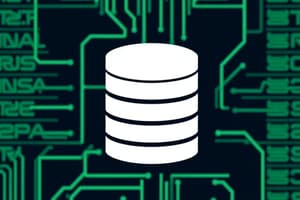Podcast
Questions and Answers
Which of the following best describes the role of a Data Management system within an organization?
Which of the following best describes the role of a Data Management system within an organization?
- Overseeing the physical security of database servers.
- Managing the flow of data from creation to obsolescence. (correct)
- Creating marketing strategies based on data analysis.
- Developing new software applications for data entry.
What is the primary role of a Data Warehouse, as opposed to a standard database?
What is the primary role of a Data Warehouse, as opposed to a standard database?
- To ensure data is stored in a completely unorganized manner.
- To support complex analysis and decision-making. (correct)
- To provide real-time transaction processing.
- To manage day-to-day operational data.
Which of the following scenarios would benefit most from using a Data Mart instead of a Data Warehouse?
Which of the following scenarios would benefit most from using a Data Mart instead of a Data Warehouse?
- An organization wants to implement a new customer relationship management (CRM) system.
- A large corporation needs to integrate data from all departments for enterprise-wide analysis.
- A company needs to process high volumes of real-time transactions.
- A small marketing team wants to analyze campaign performance data. (correct)
A financial transaction involves transferring funds from one account to another. According to ACID principles, what does 'Atomicity' ensure in this transaction?
A financial transaction involves transferring funds from one account to another. According to ACID principles, what does 'Atomicity' ensure in this transaction?
What is the key advantage of a distributed database architecture compared to a centralized database?
What is the key advantage of a distributed database architecture compared to a centralized database?
Which operation is NOT typically associated with CRUD (Create, Read, Update, Delete) operations in a DBMS?
Which operation is NOT typically associated with CRUD (Create, Read, Update, Delete) operations in a DBMS?
An e-commerce website needs to handle a large number of concurrent transactions while maintaining data integrity. Which type of database system is most suitable for this?
An e-commerce website needs to handle a large number of concurrent transactions while maintaining data integrity. Which type of database system is most suitable for this?
What is the primary function of a database query language?
What is the primary function of a database query language?
In a hierarchical database model, how are data elements related?
In a hierarchical database model, how are data elements related?
Which database model is most suitable for representing complex relationships where a record can have multiple parent records?
Which database model is most suitable for representing complex relationships where a record can have multiple parent records?
Why is the relational data model widely used in database management?
Why is the relational data model widely used in database management?
Which of the following is a key characteristic of a declarative language like SQL?
Which of the following is a key characteristic of a declarative language like SQL?
According to the CAP theorem, what is a fundamental limitation in distributed databases?
According to the CAP theorem, what is a fundamental limitation in distributed databases?
What is the primary goal of Extract, Transform, Load (ETL) processes?
What is the primary goal of Extract, Transform, Load (ETL) processes?
Which of the following best describes the purpose of 'Change Data Capture' (CDC)?
Which of the following best describes the purpose of 'Change Data Capture' (CDC)?
What is the primary benefit of data deduplication?
What is the primary benefit of data deduplication?
What is the main advantage of using a cloud data warehouse (CDW)?
What is the main advantage of using a cloud data warehouse (CDW)?
What does data governance encompass?
What does data governance encompass?
Why is master data management (MDM) crucial for organizations?
Why is master data management (MDM) crucial for organizations?
What is the primary focus of 'customer-centric' approach in business?
What is the primary focus of 'customer-centric' approach in business?
Flashcards
Data Management
Data Management
Managing data flow from creation to deletion.
Database
Database
A systematic collection of data sets or records.
Database Management System (DBMS)
Database Management System (DBMS)
Software for organized data storage and management, used for processing and querying.
Data Warehouse
Data Warehouse
Signup and view all the flashcards
Data Mart
Data Mart
Signup and view all the flashcards
Transaction
Transaction
Signup and view all the flashcards
Atomicity
Atomicity
Signup and view all the flashcards
Consistency
Consistency
Signup and view all the flashcards
Isolation
Isolation
Signup and view all the flashcards
Durability
Durability
Signup and view all the flashcards
CRUD
CRUD
Signup and view all the flashcards
Online Transaction Processing (OLTP)
Online Transaction Processing (OLTP)
Signup and view all the flashcards
Online Analytics Processing (OLAP)
Online Analytics Processing (OLAP)
Signup and view all the flashcards
Structured Query Language (SQL)
Structured Query Language (SQL)
Signup and view all the flashcards
Not Only SQL (NoSQL)
Not Only SQL (NoSQL)
Signup and view all the flashcards
Extract, Transform, Load (ETL)
Extract, Transform, Load (ETL)
Signup and view all the flashcards
Change Data Capture (CDC)
Change Data Capture (CDC)
Signup and view all the flashcards
Data Deduplication
Data Deduplication
Signup and view all the flashcards
Cloud Data Warehouse (CDW)
Cloud Data Warehouse (CDW)
Signup and view all the flashcards
Active Data Warehouse (ADW)
Active Data Warehouse (ADW)
Signup and view all the flashcards
Study Notes
- Biz-tech ecosystem needs business to treat IT as an equal partner and IT needs to perform well.
- Data management describes managing data from creation and initial storage to deletion.
- Data management goals include mitigating risks/costs of regulations, meeting legal requirements, maintaining data accuracy/availability, certifying data consistency, and ensuring data conforms to organizational best practices.
- A database is a collection of data sets/records stored systematically.
- A database management system (DBMS) integrates with data collection systems to systematically store, access, and manage data optimized for fast transaction processing and querying.
- Four elements of a DBMS are data structure, data modeling language, data query language, and transaction mechanisms.
- Data structure is a specialized format for organizing/storing data and includes files, records, tables, and trees.
- Data warehouse integrates large data sets from multiple databases/data silos for complex analysis, discovery, and decision-making.
- Data mart is a small-scale data warehouse for a single function/department and is better for analyzing complex data for enterprises that cannot afford a large investment in data warehousing.
- A transaction is a single logical unit of work that accesses/modifies database contents.
- ACID test ensures data in a database meets atomicity, consistency, isolation, and durability criteria.
- Atomicity means all database modifications are completely made or discarded.
- Consistency refers to maintaining data integrity by leaving all data in a consistent state at the end of a transaction.
- Isolation separates a transaction, making it independent of others.
- Durability requires a completed transaction to become a permanent, irreversible part of the database.
- Centralized database stores all data in one physical location with better control of data quality, ease of use, IT security, and data integrity. Transmission delay and security are cons, and it is not always reliable.
- Distributed database stores portions of the database on multiple computers within a network, offering security, reliability, speed, and scalability; availability, expense, and security are cons.
- Scalability is the system's ability to grow in size to handle increasing data and user loads.
- CRUD operations are Create, Read, Update, and Delete.
- Online transaction processing (OLTP) system is how DBMS is referred. The design breaks down complex information into simpler tables.
- Online analytics processing (OLAP) optimizes data warehouses and data marts and analyzes complex data from a data warehouse.
- Database query language retrieves data from a database and info system via user queries.
- Hierarchical database has a tree-like structure based on one-to-many parent-child relationships.
- Network data model allows multiple records to link to the same parent.
- Relational data model manages data using tables to collect groups of elements into relations.
- Object-oriented database management system models data as objects containing both data and relationships.
- Blockchain is a distributed ledger represented by a chain of data blocks, it records transactions, establishes user identity and establishes contracts.
- Hash is a function that takes input and outputs a unique fixed-size hexadecimal key for the data.
- Query is an ad hoc (unplanned) user request for data.
- Structured Query Language (SQL) accesses databases using a standardized query language.
- Declarative language is a high-level programming language, allowing users to express what they want without detailing how to get it.
- Not Only SQL (NoSQL) is a non-relational database query language without a predefined schema that is designed for corporations with large numbers of daily transactions.
- CAP theorem guides NoSQL databases, which can only meet two of the three components: Consistency, Availability, and Partition.
- Fault tolerance means no single failure causes any loss of service.
- NewSQL combines SQL reliability with NoSQL speed and performance, offering better functionality, services, and ACID performance guarantees.
- Transaction mechanism helps ensure integrity and concurrency and eliminate multiplicity via committing or rollback operations.
- Committing occurs when permanent changes are performed within the transaction
- Rollback occurs when any changes to data that have been performed within an uncommitted transaction are undone
- Factors to consider when evaluating DBMS performance are: data latency, volatility, data consistency, query response time, predictability, and processing capabilities.
- Data Latency is the time between data creation and availability for querying.
- Immediate Consistency means new queries reflect updated data immediately, while eventual consistency means not all queries reflect changes uniformly, but it operates well at a low latency.
- Data warehouses are the primary source of cleansed data for analysis, reporting, and business intelligence.
- Data mart is a small-scale data warehouse supporting a single function or department.
- Extract, Transform, Load (ETL) moves data into a data warehouse by extracting, standardizing and cleaning, and loading it.
- Change data capture (CDC) processes capture changes made to data sources and applies the changes across the enterprise to keep stores synchronized.
- Data deduplication removes duplicates and standardizes data formats.
- Cloud data warehouse (CDW) is a database in a public cloud managed for analytics, scale, and ease of use.
- Active Data warehouse (ADW) captures transactions when they change and integrates them into the warehouse for real-time data warehousing and analytics.
- Enterprise data warehouses (EDW) integrate data from many databases across an enterprise.
- Data lake is a single store of raw structured, semi-structured, and unstructured enterprise data in its natural format.
- Data Governance is the management of data availability, usability, integrity, and security in an enterprise.
- Master data is business-critical info on customers, products, vendors, locations, employees, etc., serving as a layer between transactional and analytical data.
- Master data management (MDM) integrates data from sources to create a unified view.
- Data Entity is anything real/abstract a company wants to collect/store data about.
- Master file stores records describing main database entities like customers or products and is usually periodically updated.
- Customer-centric focuses on providing a positive customer experience to drive profit and competitive advantage.
- Information management is the process of collecting, storing, managing, and maintaining accurate, timely, reliable, valid, available, unique, and relevant data.
- Data life cycle begins with database storage, then data is loaded into a data warehouse for analysis, and then is used by knowledge workers or in business apps.
- Principle of diminishing data value states that the value of data decreases as it ages.
- Principle of 90/90 data use says that 90% of stored data is seldom accessed after 90 days.
- Data silos are stand-alone data stores inaccessible by other ISs or departments.
- Dirty data is of such poor quality that it cannot be trusted for decisions.
- Cost of poor quality data = Lost Business + Cost to Prevent Errors + Cost to Correct Errors.
- Electronic document is any actively worked on paper or electronic form, file, email, contract, or lease.
- Electronic record is any finalized document that is not altered.
- Electronic content includes documents, records, and unstructured data like audio, video, and multimedia files.
- Electronic document management electronically stores, maintains, and tracks electronic documents and images.
- Electronic records management system (ERMS) electronically manages record creation and maintenance using classification schemes, retention/disposal schedules, and access controls.
- Enterprise content management captures, stores, retrieves, and manages digital assets including documents, records, emails, and multimedia.
- Enterprise content management system (ECMS) captures, preserves, and manages structured and unstructured assets and secures them in compliance with policies.
Studying That Suits You
Use AI to generate personalized quizzes and flashcards to suit your learning preferences.




